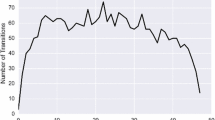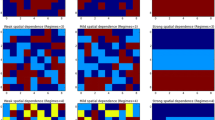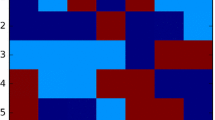Abstract
Markov chains have become a mainstay in the literature on regional income distribution dynamics and convergence. Despite its growing popularity, the Markov framework has some restrictive characteristics associated with the underlying discretization income distributions. This paper introduces several new approaches designed to mitigate some of the issues arising from discretization. Based on the examination of rank distributions, two new Markov-based chains are developed. The first explores the movement of individual economies through the income rank distribution over time. The second provides insight on the movements of ranks over geographical space and time. These also serve as the foundation for two new tests of spatial dynamics or the extent to which movements in the rank distribution are spatially clustered. An illustration of these new methods is included using income data for the lower 48 US states for the years 1929–2009.








Similar content being viewed by others
Notes
The regularity conditions for the existence of the steady state distribution require the chain is irreducible (i.e., all states communicate), although the interpretation of the limiting probabilities is slightly different depending on whether the chain is aperiodic or periodic (Ibe 2009, p. 63).
For an overview of Markov processes and measures see Ibe (2009).
All computations relied on the library PySAL (Rey and Anselin 2010).
To avoid confusion with the states of the Markov chain, the term region is used to represent a US-state in what follows.
Alabama, contiguous to Mississippi, falls in the fifth quintile in Fig. (4a) because of the large interval defining that quintile—a span of 142 years. The FMPT from Mississippi to Alabama is 114.6 years, which just exceeds the lower bound of the fifth quintile.
In the current implementation, the permutation of the set of locations is held constant over all time periods. Additionally, the local version of the spatial rank tests is subject to difficulties associated with multiple comparisons and lack of independence which plague all local statistics (Ord and Getis 2001). Future work is planned to examine the impact of alternative permutation schemes and related distributional issues.
References
Anselin L (1995) Local indicators of spatial association-LISA. Geogr Anal 27(2):93–115
Barro RJ, Sala-i-Martin X (1991) Convergence across states and regions. Brookings Paper Econ Act 1991(1):107–182
Basile R, Gress B (2005) Semi-parametric spatial auto-covariance models of regional growth in Europe. Région et Dévelopement 21:93–118
Baumol W (1986) Productivity growth, convergence and welfare: what the long run data show. Am Econ Rev 76(5):1072–1085
Bickenbach F, Bode E (2003) Evaluating the Markov property in studies of economic convergence. Int Reg Sci Rev 26(3):363–392
Bosker M (2009) The spatial evolution of regional GDP disparities in the old and the new Europe. Paper Reg Sci 88(1):3–27
Bulli S (2001) Distribution dynamics and cross-country convergence: a new approach. Scottish J Polit Econ 48(2):226–243
Cheshire P, Magrini S (2000) Endogenous processes in European regional growth: convergence and policy. Growth Change 31(4):455–479
Dall’erba S (2005) Distribution of regional income and regional funds in Europe 1989–1999: an exploratory spatial data analysis. Annal Reg Sci 39(1):121–148
Fingleton B (1984) Models of category counts. Cambridge University Press, Cambridge
Fingleton B (1997) Specification and testing of Markov chain models: an application to convergence in the European Union. Oxford Bull Econ Stat 59(3):385–403
Fingleton B (1999a) Estimates of time to economic convergence: an analysis of regions of the European Union. Int Reg Sci Rev 22(1):5–34
Fingleton B (1999b) Generalized linear models, loglinear models and regional dynamics. In: Dahlya SB (eds) The current state of economic science, vol 1. Spellbound Publications, Rohtak, pp 285–307
Fingleton B, López-Bazo E (2006) Empirical growth models with spatial effects. Paper Reg Sci 85(2):177–198
Fischer MM, Stumpner P (2008) Income distribution dynamics and cross-region convergence in Europe. J Geogr Syst 10(2):109–139
Getis A, Ord JK (1992) The analysis of spatial association by use of distance statistics. Geogr Anal 24(3):189–206
Hammond GW (2004) Metropolitan/non-metropolitan divergence: a spatial Markov chains approach. Paper Reg Sci 83(3):543–563
Ibe O (2009) Markov processes for stochastic modeling. Elsevier, Amsterdam
Jenkins S, Van Kerm P (1988) The measurement of economic inequality. Australian National University, Acton
Le Gallo J (2004) Space-time analysis of GDP disparities across European regions: a Markov chains approach. Int Reg Sci Rev 27(2):138–163
Le Gallo J, Ertur C (2003) Exploratory spatial data analysis of the distribution of regional per capita GDP in Europe, 1980–1995. Paper Reg Sci 82(2):175–201
López-Bazo E, Vaya E, Mora AJ, Suriñach J (1998) Regional economic dynamics and convergence in the European Union. Annal Reg Sci 36(3):1–28
Magrini S (1999) The evolution of income disparities among the regions of the European Union. Reg Sci Urban Econ 29(2):257–281
Maza A, Hierro M, Vitlaverde J (2010) Measuring intra-distribution dynamics: an application of different approaches to the European regions. Annal Reg Sci 45(2):313–320
Maza A, Villaverde J (2004) Regional disparities in the EU: mobility and polarization. Appl Econ Lett 11(8):517–522
Mossi MB, Aroca P, Fernandez IJ, Azzoni CR (2003) Growth dynamics and space in Brazil. Int Reg Sci Rev 26(3):393–418
Norris JR (1997) Markov chains. Cambridge, New York
Ord JK, Getis A (2001) Testing for local spatial autocorrelation in the presence of global autocorrelation. J Reg Sci 41(3):411–432
Quah DT (1993) Empirical cross-section dynamics in economic growth. Euro Econ Rev 37(2–3):426–434
Quah DT (1996a) Aggregate and regional disaggregate fluctuations. Empir Econ 21(1):137–159
Quah DT (1996b) Empirics for economic growth and convergence. Euro Econ Rev 40(6):1353–1375
Rey S (2001) Spatial empirics for economic growth and convergence. Geogr Anal 33(3):195–214
Rey SJ (2004) Spatial dependence in the evolution of regional income distributions. In: Getis A, Múr J, Zoeller H (eds) Spatial econometrics and spatial statistics. Palgrave, Hampshire, pp 193–213
Rey SJ, Anselin L (2010) PySAL: a Python library of spatial analytical methods. In: Fischer MM, Getis A (eds) Handbook of applied spatial analysis. Springer, Berlin, pp 175–193
Rey SJ, Le Gallo J (2009) Spatial analysis of economic convergence. In: Mills TC, Patterson K (eds) Handbook of econometrics volume II: applied econometrics. Palgrave Macmillan, New York, pp 1251–1290
Rey SJ, Montouri BD (1999) U.S. regional income convergence: a spatial econometric perspective. Reg Stud 33(2):145–156
Rey SJ, Ye X (2010) Comparative spatial dynamics of regional systems. In: Páez A, Le Gallo J, Buluing RN (eds). Progress in spatial analysis: methods and applications. Springer, Berlin, pp 441–463
Schettini D, Azzoni CR, Páez A (2011) Neighborhood and efficiency in manufacturing in Brazilian regions: A spatial Markov chain analysis. Int Reg Sci Rev 34(4):397–418
Tortosa-Ausina E, Pérez F, Mas M, Goerlich F (2005) Growth and convergence profiles in the Spanish provinces (1965–1997). J Reg Sci 45(1):147–182
Webber D, White P, Allen D (2005) Income convergence across US States: An analysis using measures of concordance and discordance. J Reg Sci 45(3):565–589
Acknowledgments
This research was funded in part by NSF Award OCI-1047916, SI2-SSI: Cyber GIS Software INtegration for Sustained Geospatial Innovation. I thank the anonymous referees and the editor for their constructive comments.
Author information
Authors and Affiliations
Corresponding author
Rights and permissions
About this article
Cite this article
Rey, S. Rank-based Markov chains for regional income distribution dynamics. J Geogr Syst 16, 115–137 (2014). https://doi.org/10.1007/s10109-013-0189-0
Received:
Accepted:
Published:
Issue Date:
DOI: https://doi.org/10.1007/s10109-013-0189-0




